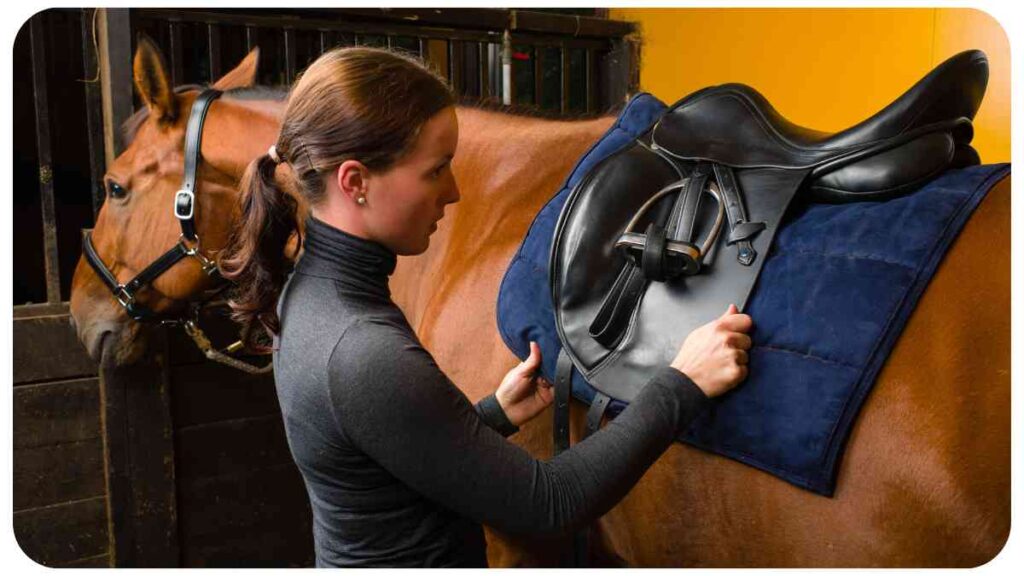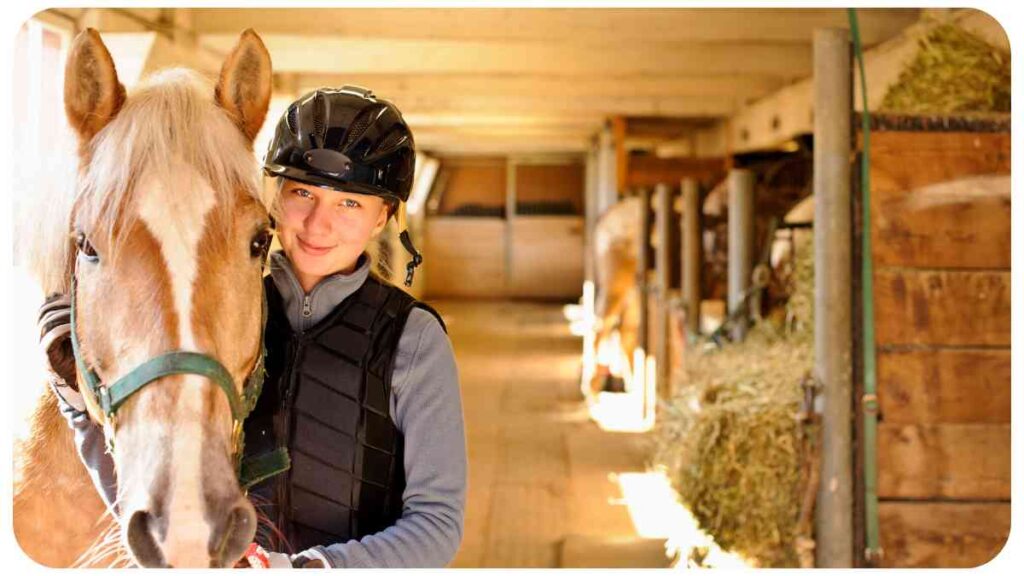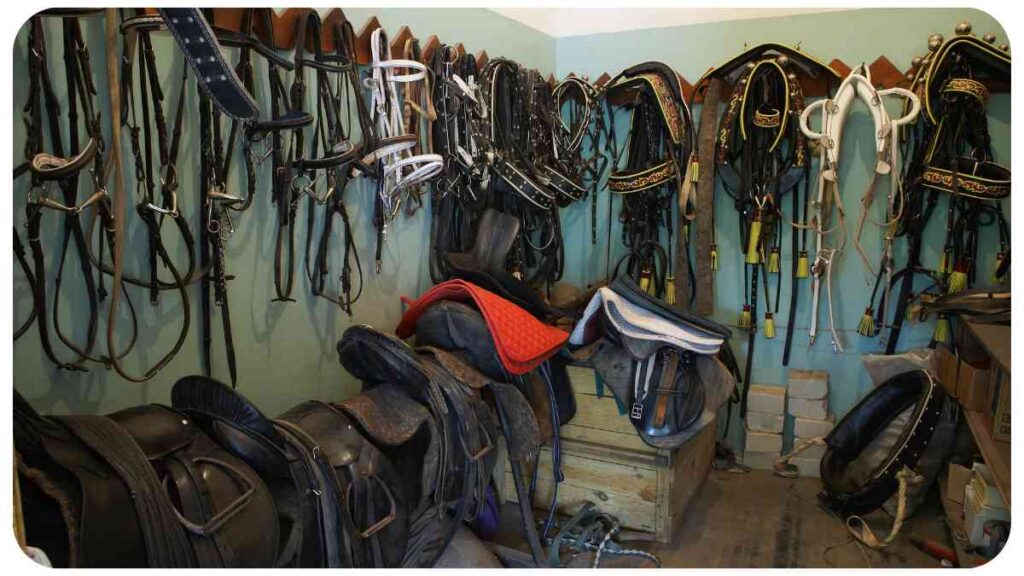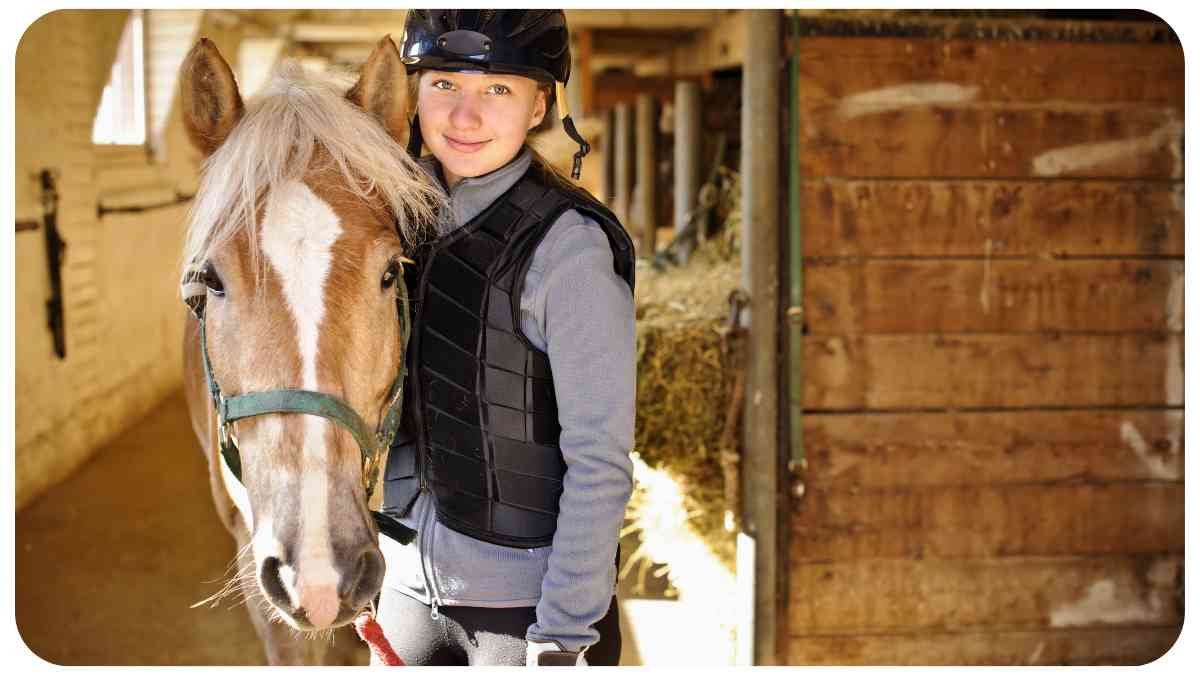As an equestrian enthusiast, you know that horse riding is not just a hobby but a way of life. Whether you’re a seasoned rider or a beginner, having the right equestrian equipment is essential for your safety, comfort, and the well-being of your horse.
However, it’s important to distinguish between the equipment you truly need and what could be considered optional. In this article, we’ll explore the world of equestrian equipment and provide guidance on what is essential and what might not be necessary for your riding pursuits.
| Takeaways |
| The essential horse riding equipment varies depending on the rider’s preference, discipline, and goals. |
| Safety gear, such as helmets and body protectors, should be a top priority for rider protection. |
| The saddle, bridle, and bit should be properly fitted and suitable for the horse and riding style. |
| Regular grooming and proper storage of tack are essential for the horse’s health and equipment longevity. |
| Consult with professionals, trainers, and experienced riders for guidance on equipment selection and care. |
2. The Essential Equestrian Equipment
Before we dive into the specifics, let’s start by outlining the fundamental equestrian equipment that every rider needs. This table provides a quick overview:
Table: Basic Equestrian Equipment
| Equipment | Function |
| Helmets | Head protection |
| Riding Boots | Foot support |
| Breeches | Comfortable attire |
| Gloves | Hand grip |
| Whip | Communication tool |
| Riding Crop | Encouragement aid |
| Mounting Block | Easy horse mounting |
It’s important to prioritize safety and invest in reliable protective gear. Helmets, for instance, are crucial for preventing head injuries in case of a fall. Riding boots provide proper support and protect your feet from potential accidents and injuries. Breeches offer comfort and flexibility, enhancing your riding experience.
“When it comes to horseback riding, having the right equipment is crucial. From saddles to helmets, every piece serves a purpose in ensuring your safety and comfort. Check out our guide on essential horseback riding equipment to make sure you’re well-prepared for your next ride.
Gloves with good grip enable better control of the reins and prevent blisters on your hands. Whips and riding crops, when used correctly and responsibly, help you communicate with your horse effectively. Lastly, a mounting block makes it easier and safer for riders to mount and dismount their horses.
3. Saddles: Finding the Perfect Fit

One of the most important pieces of equipment for horse riding is the saddle. A well-fitted saddle ensures rider comfort and aids in maintaining balance and stability. There are various types of saddles available, each designed for specific disciplines and purposes. Let’s take a look at some common saddle types and their uses:
Table: Saddle Types and Their Uses
| Saddle Type | Description | Purpose |
| All-Purpose | Versatile saddle for multi-discipline riding | Suitable for both jumping and flatwork |
| Dressage | Deep seat, long flaps, emphasis on rider position | Ideal for precision and control during dressage |
| Jumping | Forward-cut flaps, padded knee rolls, shorter stirrups | Designed for jumping activities and agility |
| Western | Heavier, larger saddle with a horn and deep seat | Suited for Western riding and ranch work |
| Endurance | Lightweight, comfortable for long-distance riding | Built for extended hours in the saddle |
Choosing the right saddle depends on the type of riding you intend to do and the comfort level of both you and your horse. Seek advice from experienced riders or consult with a professional saddle fitter to ensure a proper fit.
Finding the perfect saddle for your horse is essential for a comfortable and successful ride. Our comprehensive guide on choosing the perfect saddle will help you understand the factors to consider and make an informed decision for the ultimate riding experience
4. Bridles and Bits: Communication Tools
Bridles and bits are essential tools for rider communication and control of the horse. Bridles consist of various components such as the headpiece, browband, cheekpieces, noseband, and reins, while bits are the mouthpiece that goes inside the horse’s mouth.
Different horses may require different types of bridles and bits based on their size, shape, and sensitivity. Let’s explore some common varieties:
Table: Bridle and Bit Varieties
| Bridle Type | Bit Type | Purpose |
| Snaffle | Eggbutt, D-ring, loose ring | Gentle bit for basic communication and training |
| Double Bridle | Weymouth and Bradoon | Advanced communication and collection |
| Hackamore | Curb chain or leather noseband | Bitless bridle for horses requiring alternative communication |
When selecting a bridle and bit, consider the horse’s training level, temperament, and mouth sensitivity. Consult a professional trainer or experienced equestrians to determine the most suitable options for your horse.
5. Protective Gear for Riders and Horses

Safety should always be a top priority when participating in horse riding activities. Both riders and horses require protective gear to minimize the risk of injuries. Let’s take a look at some essential safety equipment for both:
Different disciplines require specific bridles to maximize performance and communication with your horse. Discover the best options for your riding style in our article on horseback riding bridles. Enhance your connection and achieve greater results in your chosen discipline.
Table: Safety Gear for Riders and Horses
| Rider Gear | Purpose |
| Riding Helmet | Protects the head from potential impact and reduces brain injuries |
| Body Protector | Provides protection to the torso and spine |
| Riding Vest | Offers additional torso protection for specific disciplines |
| Riding Gloves | Enhances grip and protects the hands from friction |
| Safety Stirrups | Prevents the foot from getting caught in the stirrup |
| Horse Gear | Purpose |
| Hock Boots | Protects the hock joints from injuries and reduces swelling |
| Bell Boots | Guards the horse’s hooves and pasterns from strikes |
| Fly Mask | Shields the horse’s face and eyes from flies and UV rays |
| Leg Wraps/Bandages | Supports the tendons and ligaments during intense workouts |
| Tail Guard | Prevents the tail from getting tangled or rubbed |
Investing in quality protective gear for both rider and horse demonstrates a commitment to safety and responsible horsemanship.
6. Grooming Tools: Keeping Your Horse Pristine
Proper grooming is vital for maintaining your horse’s physical health, appearance, and overall well-being. Regular grooming sessions not only enhance the bond between you and your horse but also help you identify any potential health issues. Here are some essential grooming tools every horse owner should have:
Table: Essential Grooming Tools
| Grooming Tool | Purpose |
| Curry Comb | Loosens dirt and debris from the horse’s coat |
| Body Brush | Removes loose hair and debris from the coat |
| Mane and Tail Comb | Detangles and straightens the mane and tail hair |
| Hoof Pick | Cleans dirt and debris from the hooves |
| Shedding Blade | Removes loose hair during shedding seasons |
Ensuring your horse is clean and well-groomed not only contributes to their overall health but also presents a professional and well-cared-for image.
Properly fitting horseback riding boots are not only essential for your comfort but also for your safety. Learn about the importance of finding the right fit and how it affects your riding experience in our informative piece on fitting horseback riding boots. Don’t compromise on safety or style.
7. Training Equipment: Enhancing Performance
To enhance your horse’s performance and training, there are various types of equipment available. These tools assist in developing your horse’s abilities, improving their strength, flexibility, and communication with the rider. Let’s explore some common training equipment:
Table: Training Equipment Types and Purposes
| Training Equipment | Purpose |
| Lunging Equipment | Develops balance, obedience, and promotes muscle growth |
| Ground Poles/Cavaletti | Improve coordination, rhythm, and stride length |
| Training Cones | Creates boundaries and aids in precision during exercises |
| Dressage Letters | Provides markers for dressage training and tests |
| Lunge Line | A long rein used in lunging exercises |
These training tools should be used under the supervision of a qualified trainer or instructor. Each exercise has specific objectives and should be incorporated into a structured training regimen to maximize their benefits.
8. Tack Storage and Organization

With a wide range of equestrian equipment, it’s crucial to have an organized system in place to store and maintain your tack. Keeping your gear properly stored not only ensures its longevity but also saves you time when preparing for rides. Consider the following storage options:
Table: Tack Storage Options
| Storage Option | Description |
| Saddle Rack | Holds saddles securely, preventing damage and maintaining shape |
| Bridle Hooks | Keeps bridles and reins organized and within easy reach |
| Tack Trunk/Cabinet | Offers ample space to store multiple pieces of equipment |
| Tack Cleaning Kit | Contains supplies for cleaning and conditioning your tack |
| Grooming Box | Stores grooming tools and supplies for convenient access |
Maintaining the cleanliness and good condition of your tack through proper storage will prolong its lifespan and ensure its effectiveness when in use.
9. Horse Feed and Supplements
Proper nutrition plays a crucial role in your horse’s health, performance, and overall well-being. Along with high-quality forage, horses may require additional feed and supplements to meet their specific dietary needs. Here are some popular horse feed and supplements:
Table: Popular Horse Feed and Supplements
| Feed/Supplement | Purpose |
| Hay | Provides roughage and essential nutrients |
| Grain | Adds extra calories and energy for performance |
| Balancer Pellets | Ensures balanced nutrition with essential vitamins |
| Electrolyte Supplements | Replenishes electrolytes lost through sweating |
| Joint Supplements | Supports joint health and reduces inflammation |
It’s important to consult with a veterinarian or equine nutritionist to develop a feeding program tailored to your horse’s individual needs and activity level.
10. Horse Care Products: Maintaining Health and Hygiene
Proper horse care goes beyond nutrition and grooming. Certain care products are designed to maintain your horse’s health, hygiene, and overall comfort. Here are some must-have horse care products:
Table: Must-Have Horse Care Products
| Care Product | Purpose |
| Fly Spray | Repels flies, ticks, and other insects |
| Hoof Oil/Paste | Nourishes and protects the hooves |
| Wound Dressing | Aids in the healing process of cuts and wounds |
| Mane and Tail Detangler | Removes tangles and keeps the hair healthy |
| Coat Shine Spray | Enhances the shine and appearance of the coat |
Using appropriate care products helps in preventing common issues and maintaining your horse’s overall well-being.
Before you start riding, it’s important to establish a solid foundation and build a connection with your horse through ground work. Discover the significance of ground work in horse training and how it can benefit you and your horse in our article on ground work in horse training. Lay the groundwork for a strong bond and successful riding journey
11. Conclusion
In conclusion, while there is a wide range of equestrian equipment available, it’s important to prioritize the essentials based on your riding goals and the well-being of your horse. Safety gear like helmets, boots, and body protectors are crucial for rider protection. The saddle, bridle, and bit should be carefully selected to ensure the comfort and communication between you and your horse.
Grooming tools, training equipment, and proper tack storage contribute to the overall care and maintenance of your horse. Pay attention to their nutrition, with a combination of hay, grain, and supplements tailored to their specific needs. And don’t forget about the necessary horse care products to maintain their health, comfort, and hygiene.
Remember, it’s essential to consult with experienced riders, trainers, and professionals in the equestrian community to gain insights and advice on the appropriate equipment for your specific discipline and riding goals. By investing in the right equipment and caring for your horse’s needs, you’ll enjoy a safe, fulfilling, and successful equestrian journey.
Now that you have a deeper understanding of equestrian equipment and its importance, you can make informed decisions on what equipment is essential for you and your horse. Happy riding!
Further Reading
Here are some additional resources that provide more information on equestrian equipment and what you need for horse riding:
Farm House Tack: Horse Riding Equipment List – What Do You Really Need?
This article provides insights into the essential horse riding equipment and helps differentiate between necessary and optional gear, ensuring you have what you need for a safe and enjoyable ride.
Horse Rookie: Horse Riding Equipment List
Horse Rookie offers a comprehensive guide to horse riding equipment, covering essential gear for both rider and horse, including safety gear, saddles, bridles, and grooming tools.
Theashva: Horse Riding Equipment Needed – A Beginner’s Guide to Horse Riding
This beginner’s guide provides an overview of the horse riding equipment needed to get started. It covers essential gear, such as helmets, boots, saddles, and bridles, offering helpful tips and recommendations for beginners.
FAQs
What are the essential equestrian equipment for horse riding?
The essential equestrian equipment for horse riding includes helmets, riding boots, breeches, gloves, whips, riding crops, and mounting blocks.
How do I choose the right saddle for my horse?
To choose the right saddle for your horse, you should consider its discipline, fit, and your riding style. Professional guidance from a saddle fitter can ensure a proper fit.
What types of bridles and bits are commonly used?
Common types of bridles include snaffle bridles, double bridles, and hackamores. Bits can vary in design, such as eggbutt, D-ring, loose ring, Weymouth, and Bradoon, depending on the communication and control desired.
What safety gear should riders use?
Riders should use safety gear like helmets, body protectors, riding vests, riding gloves, and safety stirrups to minimize the risk of injuries while horse riding.
How should I store and organize my tack?
Proper tack storage can be achieved using saddle racks, bridle hooks, tack trunks/cabinets, tack cleaning kits, and grooming boxes to keep your equipment organized, safe, and easily accessible.

Hi there! My name is Hellen James, and I’m a horse riding expert. I’ve been riding horses since I was just a kid—and it’s been my passion ever since. But getting started with horse riding can be overwhelming. There’s so much to learn! If you’re looking for a way to get started and make sure you’re doing it right, I’m here to help.


